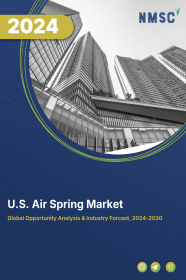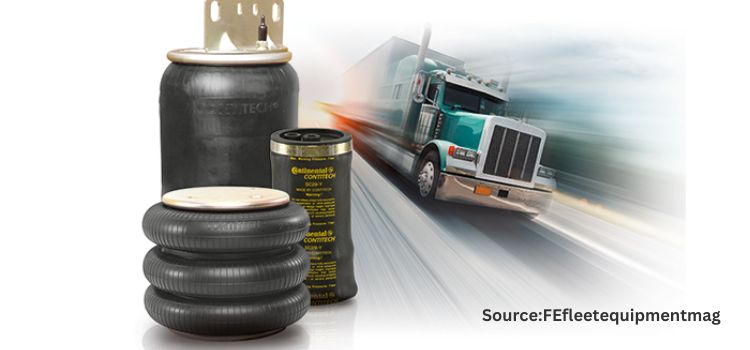
U.S. Air Spring Market by Type (Convolute, Rolling Lobe, and Sleeve), Sales Channel (Original Equipment Manufacturer (OEM) and Aftermarket), and Application (Automotive, Railway, and Industrial) – Global Opportunity Analysis and Industry Forecast, 2024–2030
Industry: Automotive & Transportation | Publish Date: 03-Jul-2024 | No of Pages: 125 | No. of Tables: 92 | No. of Figures: 57 | Format: PDF | Report Code : N/A
US Tariff Impact on U.S. Air Spring Market
Trump Tariffs Are Reshaping Global Business
The U.S. Air Spring Market Overview
The U.S. Air Spring Market size was valued at USD 1.15 billion in 2023, and is predicted to reach USD 1.86 billion by 2030, at a CAGR of 6.0% from 2024 to 2030. Also, the air spring market is valued at 5.3 million units in 2023, and is expected to reach at 9.4 million units by 2030 with the CAGR of 7.2% during 2024-2030.
The air spring, also known as air bags or pneumatic springs refers to the industry focused on the production and distribution of these springs, which are components used in vehicle suspension systems to provide improved ride quality, comfort, and stability. It is a component used in commercial vehicles, passenger cars, and industrial machinery.
The component is designed to support loads, isolate vibrations and shocks, and act as a pneumatic cylinder by expanding itself. They are integral components of air suspension systems, providing improved comfort compared to traditional coil springs. These springs replaces traditional metal springs with a flexible, rubber-and-fabric bladder that contains compressed air, making them a popular choice for various applications.
The Increasing Government Initiatives Drives the U.S. Air Spring Market Growth
The air spring market in the United States is experiencing a surge propelled by government initiatives aimed at enhancing passenger safety and implementing advanced automotive technologies, particularly emergency braking systems.
These regulations mandate the integration of sophisticated air spring technologies capable of absorbing shock and vibrations during emergency braking scenarios. For instance, the U.S. Department of Transportation's National Highway Traffic Safety Administration (NHTSA) issued a new Federal Motor Vehicle Safety Standard in April 2024, requiring automatic emergency braking (AEB) in all passenger cars and light trucks by September 2029.
This regulatory focus on safety and braking performance directly stimulates the demand for air springs, aligning with the broader objective of improving automotive safety standards and fostering innovation in suspension technologies.
The Rising Car Sales is Driving Demand for the U.S. Air Springs Market Growth
The increasing car sales are driving the U.S. air spring market growth by boosting demand for these components in new vehicles. As more cars are sold, automakers face pressure to enhance ride comfort, vehicle stability, and overall performance to meet consumer expectations.
According to data provided by the National Automobile Dealers Association (NADA), 15.4 million units of new vehicles were sold in 2022, reflecting a 3.4% increase from 2021. This surge in car sales directly translates to increased production and integration of air spring systems in electric vehicles, thereby propelling the growth of the air spring market.
High Complexity in Installing Hinders the U.S. Air Spring Market Growth
The installation process for these springs presents a formidable challenge, impeding U.S. air spring market expansion. Specialized knowledge and tools are requisite for air bag installation, resulting in increased time and costs for both manufacturers and end-users.
Furthermore, the intricate installation procedure is prone to errors or inefficiencies, thereby compromising overall performance and reliability. Consequently, the complexities associated with air spring installation dissuade potential customers from embracing these products, consequently restricting market growth.
Integration of Sensor Technology in Air Springs Creates Opportunity
The incorporation of sensor technology into these springs is anticipated to unlock future market prospects. By integrating sensors into air bag systems, manufacturers can conduct real-time monitoring of pressure, temperature, and other critical parameters. This capability facilitates proactive maintenance, predictive analytics, and enhanced performance optimization, thereby boosting reliability and safety.
Furthermore, sensor-enabled air springs are poised to catalyze the development of intelligent, adaptive suspension systems capable of automatically adapting to diverse road conditions and driving dynamics. With the automotive and industrial sectors increasingly prioritizing efficiency and automation, the demand for sensor-equipped air bags is expected to engender substantial growth opportunities in the foreseeable future.
Notably, key players in this domain such as Continental AG and Vibracoustic are spearheading innovation by integrating ultrasonic sensors into their air bags, underscoring the industry's dedication to advancement and progress.
Competitive Landscape
The promising key players operating in the U.S. air spring industry include Continental AG, Bridgestone Industrial, Vibracoustic SE, Sumitomo Electric Industries, Ltd., Trelleborg AB, VDL Groep, Airtech (Akta? Holding), Hendrickson USA, L.L.C., BWI Group, Stemco, among others.
U.S. Air Spring Market Key Segments
By Type
-
Convolute
-
Single
-
Multi
-
-
Rolling Lobe
-
Sleeve
By Sales Channel
-
Original Equipment Manufacturer (OEM)
-
Aftermarket
By Application
-
Automotive
-
Passenger Cars
-
Buses
-
Trailer and Trucks
-
-
Railways
-
Industrial
REPORT SCOPE AND SEGMENTATION:
|
Parameters |
Details |
|
Market Size Value in 2023 |
USD 1.15 billion |
|
Revenue Forecast in 2030 |
USD 1.86 billion |
|
Market Size Volume in 2023 |
5.3 million units |
|
Volume Forecast in 2030 |
9.4 million units |
|
Value Growth Rate |
CAGR of 6.0% from 2024 to 2030 |
|
Volume Growth Rate |
CAGR of 7.2% from 2024-2030 |
|
Analysis Period |
2023–2030 |
|
Base Year Considered |
2023 |
|
Forecast Period |
2024–2030 |
|
Market Size Estimation |
Billion (USD) |
|
Market Volume Estimation |
Million Unit |
|
Growth Factors |
|
|
Companies Profiled |
10 |
|
Customization Scope |
Free customization (equivalent up to 80 working hours of analysts) after purchase. Addition or alteration to country, regional, and segment scope. |
|
Pricing and Purchase Options |
Avail customized purchase options to meet your exact research needs. |
KEY PLAYERS
-
Continental AG
-
Bridgestone Industrial
-
Vibracoustic SE
-
Sumitomo Electric Industries, Ltd.
-
Trelleborg AB
-
VDL Groep
-
Airtech (Akta? Holding)
-
Hendrickson USA, L.L.C.
-
BWI Group
-
Stemco

















 Speak to Our Analyst
Speak to Our Analyst





















